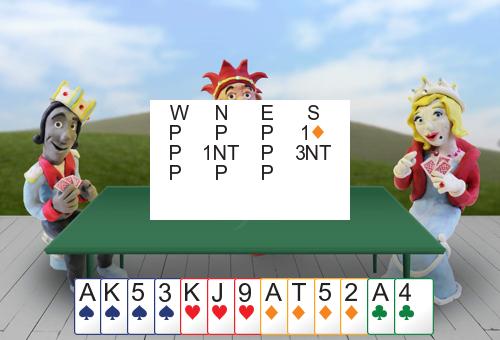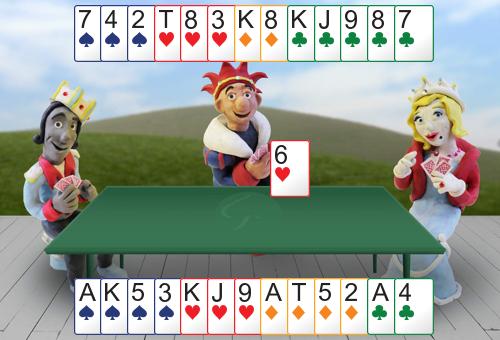Using hand shapes to remember the cards played in bridge
Remembering the cards played in bridge using hand shapes makes counting so much easier.
In reality, we really want to figure out what cards are left rather than remember what's gone.
We bid to 3NT

I've got 19 high card points. I'm going to open 1♦. Some of you might open 1♠, that's okay. North bids 1NT, so North will have six to nine points and he won't have four hearts or four spades. So he's probably got clubs! So I'm just going to bid 3NT.
Clues from the lead

Indeed North has clubs and East has led the ♥6. Now that's quite likely to be the fourth highest heart. East and West are playing fourth highest leads from length. If it is fourth highest, that means East must have Ace Queen seven, six of hearts.
So I think my nine's going to win here and it does. So that's great. Let's play some clubs. We need to play clubs early because if we can set the club suit up, even if we lose a club, we've still got that king of diamonds as an entry to the north and later. So I'm going to play Ace of Clubs and I'm going to finesse the club hoping that West started with Queen third.

But he didn't. So he started with four clubs by the looks because West played the ♣T on that second round of clubs. We started with two clubs in the South hand, five in the North hand, two in the West hand, and therefore East started with four club.
East now plays ♥A and another heart, West throwing a diamond.

Count the cards!
Now stop for a second. I strongly recommend you just pause here and grab yourself a pen and paper or if you can do this in your head, do it in your head. I want you to try and think what West's remaining cards are. I don't mean the honours, but just the length in the West suits.
We know that West started with two hearts because that's the third round of hearts and West has shown out. So West started with two hearts and we are pretty sure that West started with two clubs because we played ♣A, and then on the second round West played the 10. It seems like a kind of strange card if West had another club. So West probably started with two hearts and two clubs. What does that mean about West's other suits? Well, two hearts and two clubs, and there's 13 cards in each hand. So West started with nine spades and diamonds combined and now West has thrown a diamond.
So West has got eight cards left. What length in spades and diamonds do you think West has got left now? There's a pretty good chance West has got four spades and four diamonds left. Okay, so now I'm going to play the rest of the hand out and it's not tricky. I'm just going to basically take my tricks and the reason I'm thinking about that shape that I think West started with is that trying to think about the remaining cards is so much easier than trying to remember the cards that have been played.
The concept of vacant spaces is a helpful way of calculating the likelihood of one opponents having a particular card.
So I'm just going to play ♠A, ♠K. If my guess is right, I don't think East has got any spades left. I think West has got two spades left and four diamonds left. So I'm going to play KD, KC and run the club suit.
Do try this hand with pen and paper and you'll see that poor West is forced to either throw away diamonds or spades and, either way, we end up with the rest of the tricks.
The important thing here is that most people try and remember the cards by saying, oh, that's one gone, two gone, three gone, four gone, and you're trying to remember all this stuff in your head. It's really, really hard. I can't do that. The only way I can figure out what's left or is by actually trying to think about what's left.
Practice counting
Use the shape machine to practice quickly recognising hand shapes.
| - | - | - | - | .
tags: #counting
